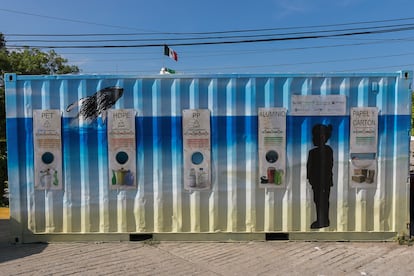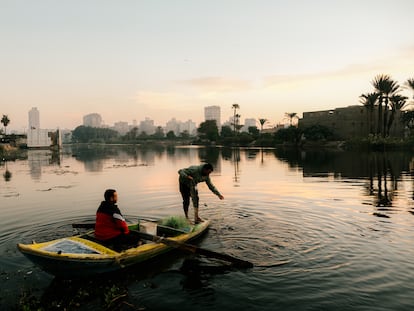How plastic is flooding the Mexican coast
In some coastal towns in Oaxaca, private recycling initiatives have sprung up. But production of the material continues unabated

In Mexico, the majority of waste that is not collected is plastic, which ultimately finds its way to the coast. It is the debris that is carried by ocean currents until it accumulates on the shores, later returning out to sea and carried by the waves. Or it lies fading in the sun and brackish water, tangled in the roots of mangroves, in ecosystems that have become impromptu garbage dumps.
According to a report from the Ministry of Environment and Natural Resources (Semarnat), pollution on the Mexican coasts has reached critical levels, with the states of Oaxaca, Guerrero, Chiapas, and Veracruz leading the way. “It is very difficult to quantify how much garbage ends up in the natural environment. But, it is estimated that the equivalent of two truckloads of plastic garbage is emptied into the ocean every minute,” says Nick Leopold, director of Plastic-Free Oceans at Oceana, a marine conservation organization. “Materials travel from cities by rivers, or through the air, and have a very heavy impact on ecosystems,” says Leopold, who is responsible for a recently launched campaign to regulate the use of unnecessary plastics in the capital.
In Mexico, where less than 6% of plastic is recycled, the absence of plastic waste management measures is one of the main reasons for the pollution. A problem that is increasing in rural municipalities far from urban centers that lack a public garbage collection service. In the absence of efficient government policies to address this serious challenge, private initiatives and civil society organizations dedicate funds so that plastic garbage — which kills more than a million marine species a year — does not end up in the ocean. This is the case for a network of alliances called Comunidad Nit, which originated on the coast of Oaxaca and were founded to promote recycling and foster the circular economy. This project, promoted by Femsa, an association that belongs to Coca-Cola, seeks to minimize marine pollution and strengthen the recycling chain at various points along the Mexican Pacific coast.
To this end, recyclable waste collection sites were installed on beaches in Puerto Escondido, a coastal destination that is popular among tourists. The sites are used for “PET or hard plastic bottles such as liquid detergents and shampoo, polypropylene bottles, aluminum cans, paper, and cardboard, among other materials that the community can take and recycle,” explains Iberia Rodríguez, a member of the Nit Community and one of the main promoters of the initiative. According to the activist, “through the participation of residents, government, organizations, businesses, and other key tourism stakeholders, this alliance aims to prevent waste from choking ecosystems.”
According to studies on the environmental impact of plastic pollution, the most common waste that can be found in the natural environment are plates, disposable cups, bags and bottles. These plastic items make up 90% of the total garbage on some beaches. But, this is just an estimate. According to Semarnat, the information that exists on waste management is incomplete due to the lack of monitoring of plastic flows in collection centers. In Mexico, these facilities are where most of this type of waste will end its useful life.

A self-sustaining business in the informal economy
Although collection centers are responsible for recovering the majority of the material, practically all of them are unregulated. It is estimated that only 2% of the more than 2,200 in the country are completely officially controlled. The rest are supported by the informal economy. They are garbage dumps like the San Pedro Mixtepec municipal landfill, where every day a dozen day laborers go to earn a living.
In this open-air landfill, just over six miles from beaches filled with tourists, and where the Comunidad Nit and Femsa have developed their recycling project, families of waste collectors try to recover materials that still have a second life. “What we collect the most is PET and hard plastic that we take from appliances like washing machines and ovens,” says Pablo López while walking through the garbage and leaning on a cane. A flock of vultures is on the prowl. Originally from Los Nanches, a town in the municipality where the landfill is expanding, this 64-year-old Oaxacan has spent more than two-thirds of his life recycling. It is a business that generates billions of dollars annually on a global scale. However, the high profits that the plastic business earns in the market generally do not impact the actors that make up the recoverable material supply chains at the local level.
For workers like Santos, collecting plastic to sell is becoming less and less profitable. “The problem is that its price dropped a lot. If a kilo was previously at seven pesos [$0.41], now it can be bought for two pesos [$0.12]. We sell it very cheap,” says Juana López, 61, who has been collecting garbage for two decades. “We started very early. We arrived at 7 a.m. and left at 5 p.m. Come rain or shine, we are always here. But it doesn’t give us enough to live on. Between my husband and I, we can collect about 3,000 pesos [$175] a month,” says the woman.
The challenge: stopping plastic production
Demand for packaging materials and the rise of e-commerce caused the PET market to skyrocket during the pandemic. But the industry’s growing profits are not reflected in the pockets of garbage collectors. Theirs is an increasingly precarious job that puts their health at risk. Workers breathe contaminated air and are exposed to cuts from needles and other sharp instruments. “We work with our bare hands, and we have to be careful not to hurt ourselves,” says López, who supports his entire family by selling materials whose value constantly fluctuates. “The price of plastic goes up or down every two or three months. That’s why we prefer to sell metal or aluminum, which gives us much more money,” he adds, moving through the mountains of waste.
“Plastics are made from oil, which depends on the world price and is always changing,” says Leopold. The Oceana expert believes that, in the current context, the messages of recycling and the circular economy are not enough as long as new packaging made of this material continues to be produced.
The figures provided by the annual report of Petstar, the largest PET recycling infrastructure in the world, which has Coca-Cola among its shareholders, indicate that in 2022 they collected almost 101,000 tons in Mexico, but only produced 53,000 tons of recycled plastic. “This means that there is a loss of material of almost 50%, which forces us to continue extracting oil in order to make enough material to meet the demand,” laments Leopold.
According to the United Nations, most packaging is not designed to be reused. And it ends up becoming waste that, as it loses its value for the people collecting it, ends up burned in the open or dumped directly into rivers, ravines, and other natural ecosystems such as the sea. While Coca-Cola has announced the creation of 100% recyclable packaging by 2030, the international consensus points directly to the immediate elimination of unnecessary plastics. And environmental organizations advocate stopping plastics production and creating reusable packets, packaging and bottling alternatives to combat plastic pollution.

Sign up for our weekly newsletter to get more English-language news coverage from EL PAÍS USA Edition
Tu suscripción se está usando en otro dispositivo
¿Quieres añadir otro usuario a tu suscripción?
Si continúas leyendo en este dispositivo, no se podrá leer en el otro.
FlechaTu suscripción se está usando en otro dispositivo y solo puedes acceder a EL PAÍS desde un dispositivo a la vez.
Si quieres compartir tu cuenta, cambia tu suscripción a la modalidad Premium, así podrás añadir otro usuario. Cada uno accederá con su propia cuenta de email, lo que os permitirá personalizar vuestra experiencia en EL PAÍS.
¿Tienes una suscripción de empresa? Accede aquí para contratar más cuentas.
En el caso de no saber quién está usando tu cuenta, te recomendamos cambiar tu contraseña aquí.
Si decides continuar compartiendo tu cuenta, este mensaje se mostrará en tu dispositivo y en el de la otra persona que está usando tu cuenta de forma indefinida, afectando a tu experiencia de lectura. Puedes consultar aquí los términos y condiciones de la suscripción digital.










































